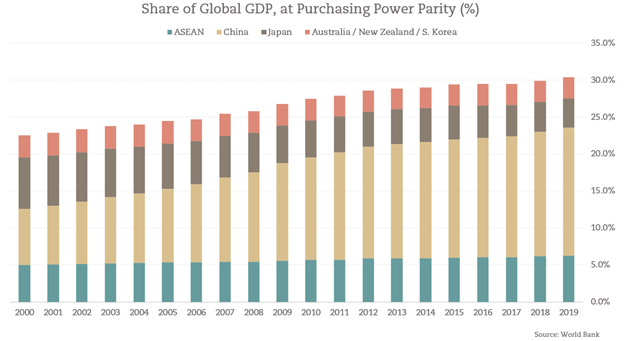On November 15th, 2020, fifteen Asia-Pacific nations signed arguably the largest free trade agreement in history — the Regional Comprehensive Economic Partnership (RCEP). This deal, which has been a long-time coming, represents a major economic development for the Asia-Pacific region.
Included in the agreement are the 10 members of the Association of Southeast Asian Nations (ASEAN) along with China, Japan, South Korea, Australia, and New Zealand. This new trade deal will combine existing agreements amongst ASEAN nations into a multilateral pact to include all 15 countries. A milestone agreement that further illustrates Asia’s emergence as a powerhouse trading bloc, putting them on the same footing as the Canada-United States-Mexico Agreement (CUSMA) and the European Union.
ECONOMIC SIGNIFICANCE
The new trade deal aims to strengthen the relationships between trading members by progressively lowering tariffs, boosting investments, and incentivizing stronger supply chains to allow for the frictionless movement of goods. For perspective, in terms of sheer size, the RCEP members represent almost one-third of the world’s population and account for roughly 30% of global GDP.

GEOPOLITICAL SIGNIFICANCE
Looking back in history, relations between the second and third largest economies in the world, China and Japan, have been riddled with longstanding political conflict and tension. Not only does the RCEP bring these two nations together, but it connects China, Japan, and South Korea in a major free trade agreement for the very first time. It is worth noting that, while India was involved in early RCEP negotiations, the country withdrew itself in late 2019. That being said, the trade bloc has left the door open for India to join at a future date.
BOTTOM LINE
At a time when the world is experiencing a massive dislocation of globalization, the new Pan-Asia trade pact marks a victory for multilateralism. While ironing out the finer details of the agreement will not occur overnight, one cannot argue the vast positive implications for the region. The integration of an Asian-wide free trade structure will further weaken America’s influence in Asia-Pacific.
The Asia-Pacific region continues to be the largest contributor to the worldwide build-up of preferential trade agreements (PTAs), accounting for about half of PTAs worldwide. They are becoming bigger, deeper, more digital, and increasingly supportive of sustainable development, which bodes well for the energy sector, mining, and infrastructure.